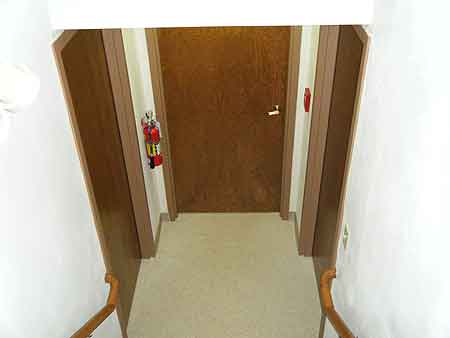Article and photo by Gregory Havel
Frequently, the basement or cellar of a new residential or commercial building is left unfinished, intended for use as storage and utility space. In older buildings, these spaces may have the exposed joists and subfloor above as the ceiling, and unpainted concrete or masonry walls. In newer buildings, the joists and subfloor may have been covered by gypsum drywall board as a fire protection feature; and masonry or wood-frame and drywall partitions may have been included to enclose heating, air-conditioning, and electrical equipment. Photo 1 shows the bottom of the basement stairway in a 20-year-old residential building. What will we find behind these three doors?

(1)
In apartment buildings, storage bins are often in the cellar or basement. Sometimes they are of wood framing and gypsum drywall. More frequently, they are wood framing covered with wire fencing, providing a minimum of security and no passive fire protection.
In any type of residential or commercial building, the cellar or basement is often divided at a later date to provide additional apartments, office space, employee lunchrooms, and space for other uses. Frequently, this construction is by the owner, tenant, or a handyman without formal plans, plans review, building permit, or inspections.
This type of construction and remodeling is illegal in many states, counties, and municipalities, and is a bad idea anywhere. Under these conditions, minimum cost is the driving factor and results in non-code compliance or is inadequate in the following areas:
- Number and location of exits from the rooms and from the basement or cellar
- Width of exit doors
- Partitions between rooms and exit corridors, with walls, doors, and frame assemblies designed for privacy rather than fire protection
- Lighting
- Exit and emergency lighting
- Heating, ventilation, and air-conditioning (HVAC)
- Fire extinguishers
- Automatic fire sprinkler protection
- Fire alarm system and smoke detector coverage
- Maintenance of fire protection features that are present
- Access to an area that will be difficult for firefighters and emergency responders and that is usually presumed to have few occupants.
Once the low-budget division of a cellar or a basement is complete, it is often difficult to persuade the owner or occupant to spend even more to make the substandard result code-compliant. The owner or occupant usually is not familiar with the terms and definitions used in building and fire codes. He may also consider the building to be private even though it is leased or rented to many unrelated individuals, or if it is a business, open to anyone who walks through the door.
A solution for the future: Expand our public fire education program to include property owners and managers, and provide them with a broader picture of fire safety than maintenance of fire extinguishers, fire exits, and exit lights. Perhaps they will even begin to use the fire and building inspectors as resources when planning projects instead of perceiving them to be evil entities that must be avoided at any cost.
Download this entire article as a PDF HERE.


